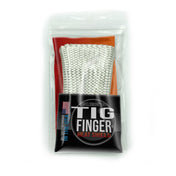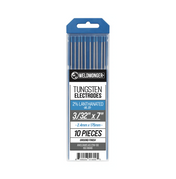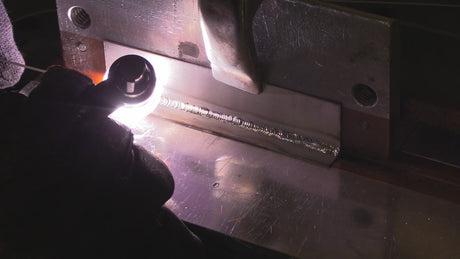Stainless TIG Welding Tips
Learn more about Weldmonger TIG cup Kits
 Getting the puddle going quickly is a key to tig welding stainless steel lap joints and tee joints.
Getting the puddle going quickly is a key to tig welding stainless steel lap joints and tee joints.
A jazzy 10 cup is a great choice for tig welding stainless steels.
I used a clear jazzy10 for the video above but mainly just because it tends to make for better arc shots since it lights things up better.
A ceramic jazzy10 works the same as a clear jazzy as far as gas shielding and tungsten stickout goes.
The video below shows different clear cups in action
Stainless TIG Welding Rods: Choosing Between ER308L, ER316L, ER347, and ER312
Selecting the right filler metal is one of the most important decisions in TIG welding stainless steel. The rod you choose affects everything from corrosion resistance to weld strength and crack resistance. In this article, we’ll look at four of the most commonly used stainless TIG filler rods:
ER308L, ER316L, ER347, and ER312—including what they’re for, when to use them, and what makes each unique.
1. ER308L – The Go-To Rod for 304 Stainless
What it’s for:
ER308L is the most commonly used filler metal for welding 304 and 304L stainless steel. It’s ideal for general-purpose stainless fabrication and offers a good balance of weldability, corrosion resistance, and affordability.
Key Characteristics:
- “L” stands for low carbon, which helps prevent carbide precipitation and cracking.
- Excellent for structural work, kitchen equipment, railings, and automotive parts.
- Good toughness, smooth arc, and low spatter.
Use When:
- Welding 304, 304L, 301, 302, or similar stainless types.
- Working on food-grade or cosmetic-quality stainless where weld color matters.
2. ER316L – Better for Corrosive Environments
What it’s for:
ER316L contains molybdenum, which improves resistance to pitting and corrosion—especially in chloride environments (like saltwater, chemicals, or industrial atmospheres).
Key Characteristics:
- Higher corrosion resistance than 308L.
- Still low in carbon for improved resistance to intergranular corrosion.
- Common in marine, chemical processing, and pharmaceutical applications.
Use When:
- Welding 316, 316L, or 316Ti stainless steel.
- Corrosion resistance is a top priority (e.g., saltwater exposure).
- Welds will be exposed to acids or chlorides.
3. ER347 – For Heat-Cycled or High-Temp Stainless
What it’s for:
ER347 is stabilized with niobium (columbium) to prevent carbide precipitation during high-temperature service. It’s a great choice for stainless that will go through thermal cycling or high-temperature operation.
Key Characteristics:
- Offers excellent creep strength at elevated temperatures.
- Resists intergranular corrosion even after prolonged heat exposure.
- Ideal for exhaust systems, furnace components, and power generation equipment.
Use When:
- Welding 321, 347, or other stabilized grades.
- The part will face thermal cycling or sustained high temperatures.
- You want extra resistance to cracking after repeated heating and cooling.
4. ER312 – For Dissimilar or Cracked Stainless
What it’s for:
ER312 is a high-strength, high-ferrite rod that’s designed to weld dissimilar metals and resist cracking in difficult-to-weld stainless alloys. It's often used for maintenance and repair.
Key Characteristics:
- High tensile strength (over 125,000 psi).
- Not alloy-specific—works across many stainless and carbon grades.
- High ferrite content improves crack resistance under stress or mismatched expansion rates.
Use When:
- Welding stainless to carbon steel, or manganese to stainless.
- The base metal is unknown, or difficult to match.
- Repairing cracked stainless parts or castings.
Quick Comparison Chart
|
Filler Rod |
Use With |
Best For |
Corrosion Resistance |
Crack Resistance |
Heat Resistance |
|
ER308L |
304, 304L, 301,303 etc |
General-purpose stainless fabrication |
Medium |
Good |
Moderate |
|
ER316L |
316, 316L |
Marine, pharma, and chemical applications |
High |
Good |
Moderate |
|
ER347 |
321, 347 |
High-temp and thermal cycling situations |
Medium |
Very Good |
Excellent |
|
ER312 |
Dissimilar/unknown |
Repairs, stainless to carbon/manganese |
Medium |
Excellent |
High |
Final Tips for Filler Rod Selection
- Always match the filler to the base material whenever possible.
- For food-grade or high-corrosion environments, go with ER316L or ER347.
- For repairs, unknown metals, or difficult welds, ER312 can be a lifesaver.
- Keep rods clean and dry—stainless filler rods are prone to contamination.
Choosing the right TIG rod for stainless is about more than just matching numbers—it’s about understanding the application, corrosion risk, temperature exposure, and the metals you're joining. Whether you're building, repairing, or fabricating, having ER308L, ER316L, ER347, and ER312 rods on hand will cover almost every stainless TIG welding situation.









3 Kommentare
Hi Jody, Thanks for all of the great videos over the years. Also my best wishes for you and your continued recovery. Chuck
Jody, I truly am praying for you and your healing. The Lord is faithful. I can attest to that through my 75 years on this earth.
Hey Jody,
Thanks again for another great video! And I wish you all the best for a speedy recovery! I have a book recommendation that you might find helpful while you are in the recovery process. The book is: Super Gut, by Dr. William Davis. I truly hope it helps! Well wishes are being sent your way!
All the best,
Jason